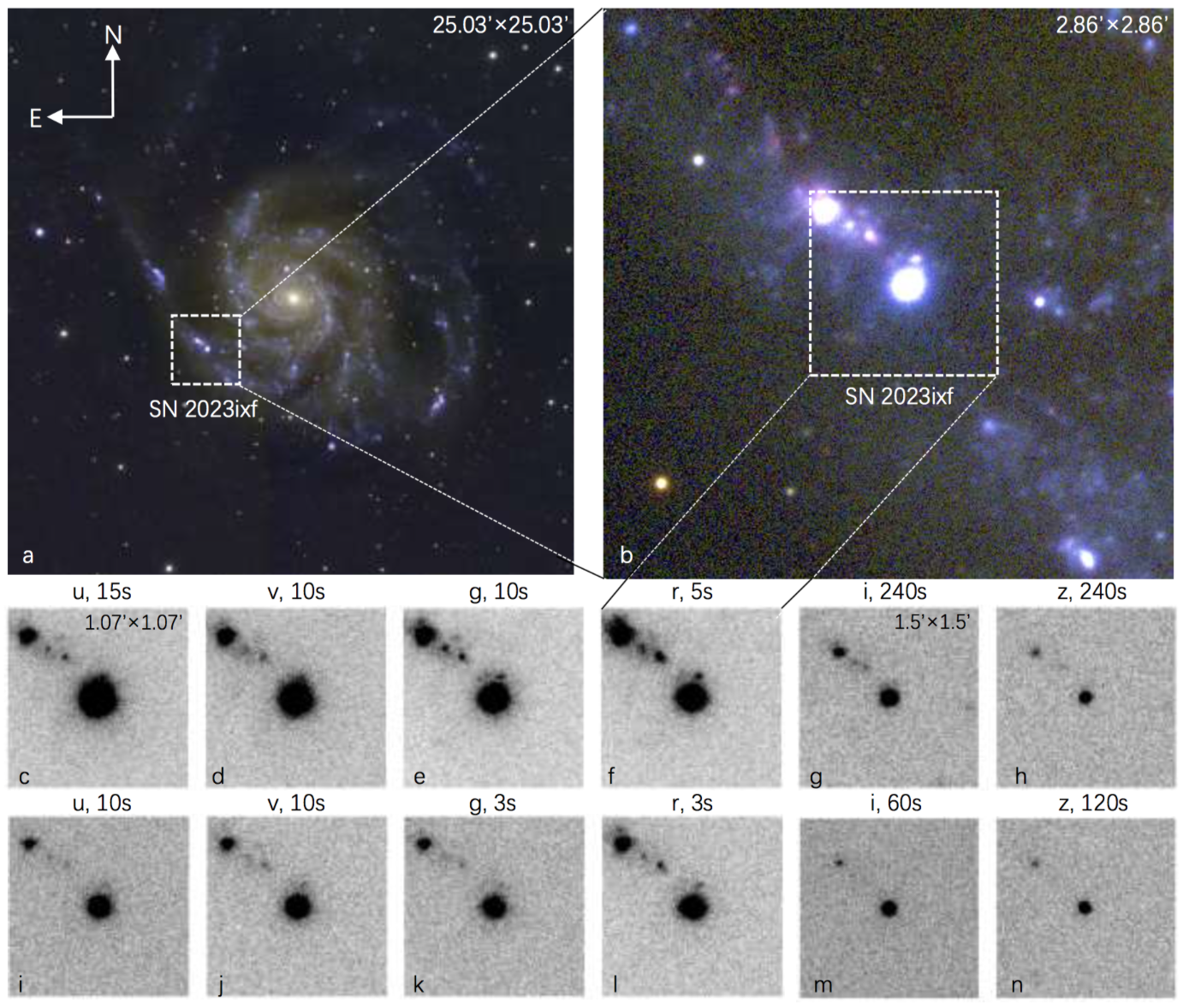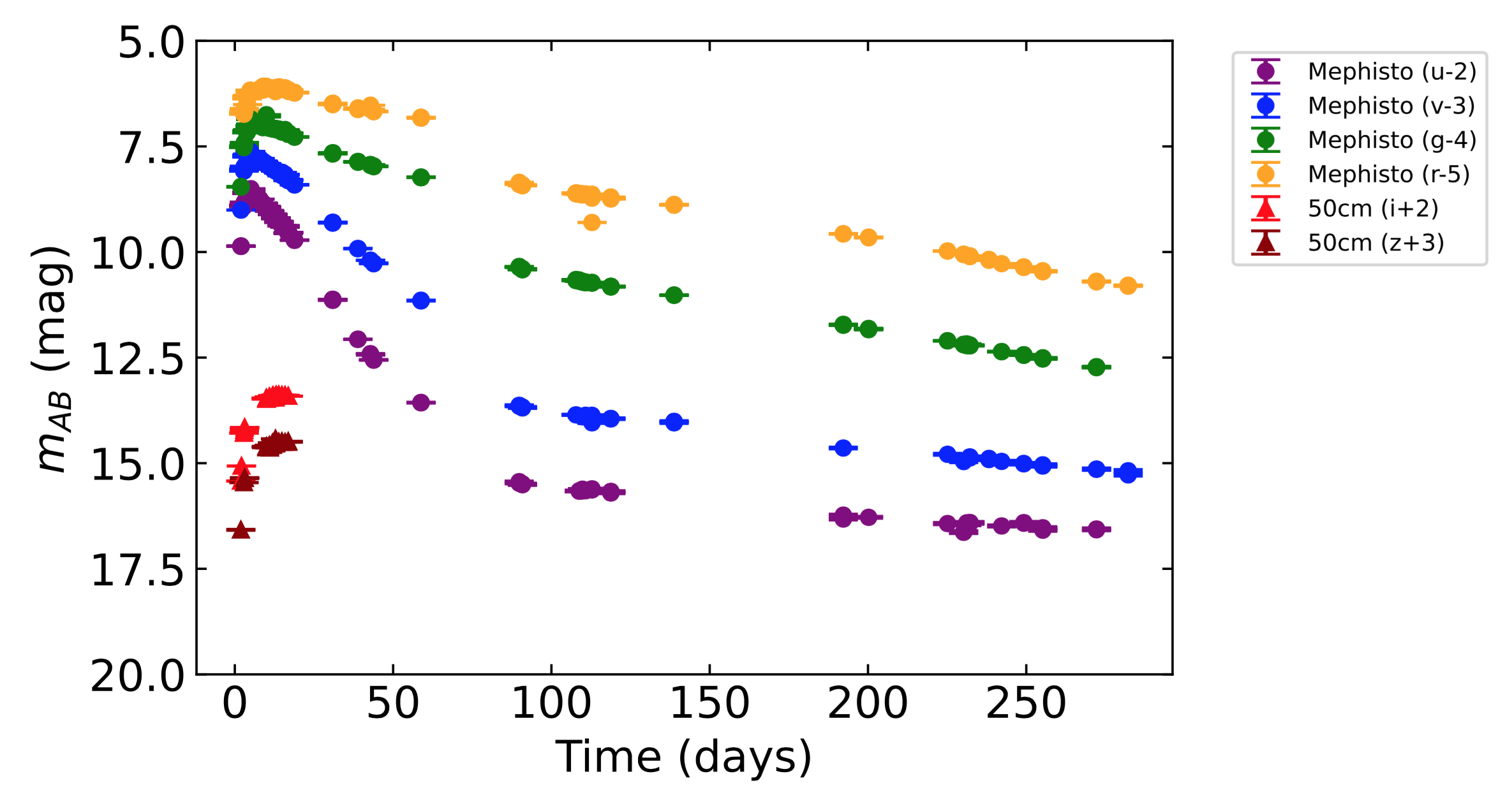云南大学梦飞巡天望远镜(Mephisto)对超新星SN 2023ixf开展多波段同时观测并取得重要发现
Multi-band Simultaneous Photometry of Type II SN 2023ixf with Mephisto
核坍缩型超新星由大质量恒星在其演化最后阶段由星核坍缩产生。当星核的辐射压无法抵抗其自身的引力时,星核坍缩并产生超新星爆发。保留大部分氢包层的核坍缩型超新星被称为II型超新星,是宇宙中最常见的超新星类型之一。其光变和能谱特征能够揭示超新星的爆发机制、星周环境,以及前身星的性质。
2023年5月19日,Koichi Itagaki探测到来自M101星系的SN 2023ixf超新星爆发。该超新星距离地球约2.1千万光年,是近十年以来爆发的一颗距离地球最近的核坍缩型超新星。M101星系作为云南大学梦飞巡天望远镜的监测目标(见图1),自2023年5月20日以来,梦飞巡天望远镜及50-cm望远镜阵列对其开展了多波段同时观测,时间跨度280多天,总曝光次数超过1200余次,提供了目前国际上针对SN 2023ixf最长期的监测数据(见图2)。利用梦飞巡天望远镜和50-cm望远镜阵列的多波段同时高精度观测数据,云南大学中国西南天文研究所梦飞团队对SN2023 ixf的爆发机制和星周环境进行约束,获得了该超新星的镍含量、爆发能量和质量,以及前身星性质等重要参数。该项工作为首篇完全基于梦飞巡天望远镜数据的时域天文学论文,已被国际天文学主流期刊《天体物理杂志》(The Astrophysical Journal)接收发表,预印本链接:http://arxiv.org/abs/2405.08327 。
云南大学1.6米多通道测光(梦飞)巡天望远镜(Mephisto)是云南大学“双一流”建设重大科研平台,是国际上首台大视场、大口径、多通道高精度成像巡天望远镜。其独特优势在于可同时在3个波段拍摄天体图像,提供超高精度测光及颜色数据,实现对海量变源暂现源的快速可靠分类,录制宇宙天体运动和变化的彩色纪录片。2022年9月,梦飞巡天望远镜开始在丽江高美古观测站安装调试,同年10月23日实现小系统双通道四波段初光,2023年12月21日, 实现蓝黄红三通道同时出光。梦飞巡天望远镜于2023年5月20日至2024年2月24日对SN 2023ixf持续开展多波段同时观测。
梦飞巡天望远镜项目由云南大学中国西南天文研究所牵头研制并运行,得到了云南省政府和云南大学“双一流”经费支持。项目团队还得到了云南省兴滇英才支持计划“科技领军人才专项”(202005AB160002)、“创新团队”(202105AE160021) 和“顶尖团队”(202305AT350002)项目支持。

图1. 梦飞巡天望远镜与50-cm望远镜阵列拍摄的M101星系及SN 2023ixf超新星的真彩色图像。
Figure 1. Real-color images of M101 galaxy and SN 2023ixf with Mephisto and the twin 50-cm telescopes.

图2. 梦飞巡天望远镜及50-cm望远镜阵列测到的超新星SN 2023ixf多波段光变曲线。
Figure 2. Multiband light curves of SN 2023ixf obtained with Mephisto and the twin 50-cm telescopes.

Core-collapse supernovae (CCSNe) arise from the core collapses of massive stars in their final evolutionary stages when the radiation pressure from the nuclear fusion in the core cannot resist its own gravity. CCSNe retaining a large portion of the hydrogen envelope are known as Type II SNe, which are among the most commonly observed SNe. Their light curves and spectra can reveal properties about the SN explosion mechanisms, the circumstellar environment and the progenitor star.
Koichi Itagaki detected an SN 2023ixf supernova explosion from the M101 galaxy on May 19, 2023. This supernova, at a distance of 21 million light-years, is one of the closest and brightest CCSNe in the last decade. M101 galaxy is one of the monitoring objectives of Mephisto, see Figure 1. Since May 20, 2023, Mephisto and the twin 50-cm telescopes have conducted simultaneous multi-band observations of SN 2023ixf with a long time span over 280 days, and accumulated over 1200 exposures (see Figure 2), providing the longest monitoring data for SN 2023ixf so far. Based on the high quality and simultaneous multi-band imaging data from Mephisto and the twin 50-cm telescopes, the SWIFAR-YNU group gave some constraints on the SN explosion mechanism and the circumstellar environment of SN 2023ixf and obtained the Ni mass, explosion energy and ejecta mass, and the properties of the progenitor star. The work is the first paper in time-domain astronomy entirely based on the Mephisto data, and it has been accepted for publication in The Astrophysical Journal (ApJ) and the arXiv link: http://arxiv.org/abs/2405.08327 .
Mephisto is a 1.6-m wide-field multi-channel telescope, the first of its type in the world, capable of imaging the same field of view in three optical bands simultaneously. It yields real-time, high-quality colors of unprecedented accuracy of billions of objects, enables fast and robust classification of variables and transients, and for the first time, delivers a panoramic and panchromatic documentary of our dynamic universe. The on-site telescope assemblage and commissioning began in September 2022, and the first light in dual channels of four bands for a pilot system covering one quarter of the full field of view was achieved on October 23, 2022. Mephisto realized the first light in blue, yellow, and red channels simultaneously on December 21, 2023. Mephisto performed multi-band simultaneous observation for SN 2023ixf from May 20, 2023 and February 24, 2024.
Mephisto is developed at and operated by SWIFAR-YNU, funded by the “Yunnan University Development Plan for World-Class University” and “Yunnan University Development Plan for World-Class Astronomy Discipline”. The project team also receives support from the “Science & Technology Champion Project” (202005AB160002) and from two “Team Projects” -- the “Innovation Team” (202105AE160021) and the “Top Team” (202305AT350002), all funded by the “Yunnan Revitalization Talent Support Program”.
